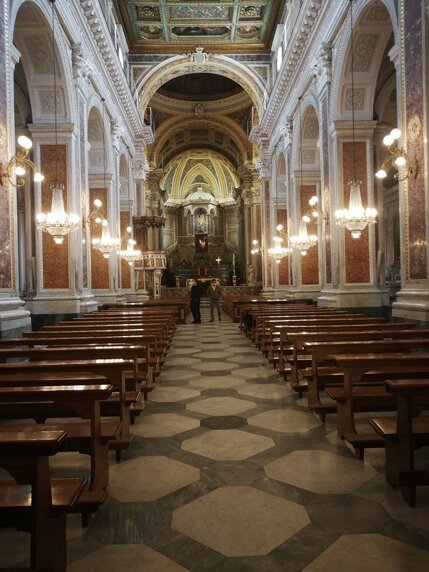.png)

.jpeg)

Basilica of Saint Michael the Archangel
Sito dell'Assessorato alla Cultura, Turismo e Spettacolo del Comune di Piano di Sorrento
- ideato e realizzato dall'Ufficio Cultura del Comune -
Tel. 0815344426 - mail: info@pianodisorrentoeventi.it
It represents the place around which, over time, the village of Carotto developed and is a true concentration of artistic works and treasures. Initially built around the 9th century (in a pastoral visit, it was described as predating Bishop Leopardo, 913–917) on a pagan temple (as evidenced by a document in the parish archive from the 15th century that calls it a "capitular estaurita church"), some believe it was dedicated to Minerva, while others think it was used as a necropolis.
In 1886, during the refurbishment of the flooring, a Roman funerary urn of uncertain date (probably from the imperial period) was discovered, bearing the inscription "diis manibus C. Volussi Isochrysi" (To the Gods, from Caius Volussius Isochrysus) along with a Byzantine-era bas-relief depicting the crucified Jesus with two figures at His feet. The original nucleus of the church likely corresponded to the area now occupied by the apse, the bell tower, and the Cota-Cafiero chapel, with the short side facing east and the bell tower on the right. Over the centuries, the church has undergone numerous renovations. It was originally almost adjacent to the nearby chapels of Santa Maria della Neve and Santa Maria di Monserrato (later becoming Santa Maria della Misericordia and SS Annunziata). In 1405, the church was virtually rebuilt after the 9th-century structure had been destroyed. Notarial acts from 1422 and 1451 mention it.
In the 16th century (1571–1575, during the bishopric of Monsignor Brancaccio), the church was extended and reoriented on the ruins of the preexisting religious building. In reality, there was a sort of merging of the buildings of Santa Maria della Neve, Santa Maria di Monserrato, and the small ancient church of San Michele. In 1451, the church became a parish.
In 1522, the University of Piano was authorized to meet at the church of San Michele. In 1559, the citizens of Carotto joined the Massa, Maresca, and Cacace families, who until then had exclusively appointed parish priests and maintained the church.
In 1688, an earthquake caused the collapse of the bell tower, the main dome above the crossing, parts of the naves, and the outer facade. Reconstruction and restoration work was completed in 1726, when the church was reconsecrated by the Archbishop of Sorrento, Ludovico Agnello Anastasio. An ancient convent structure is annexed to the church, preserving a chapel and terracotta floors with maiolica tiles from the early 19th century. In 1726, the faithful of Carotto decided in a parliamentary assembly to elevate the parish to a collegiate church with seven canons.
In 1914, Pope Benedict XV elevated the church to a pontifical basilica (the papal coat of arms and a cross were then placed on the tympanum's peak). The facade is Baroque, with a monumental 16th-century portal featuring a fresco of Saint Michael banishing Satan, half-columns, pilasters, and entablatures, elevated above the street by a stone staircase. The bell tower, dating back to the 16th century, was damaged in the 1688 earthquake but later rebuilt. It has a square plan and three tiers, featuring a clock and a belfry with single windows.
The interior is structured with three naves and a Latin cross layout. It boasts a remarkable gilded coffered ceiling containing seven paintings attributed by some scholars to Girolamo Imparato and by others to greats like Francesco Solimena and Paolo De Matteis. These paintings depict the life of Saint Michael, including one signed by R. De Crescenzo ("Saint Michael Appearing in a Dream to the Bishop of Siponto") and another ("The Saint's Appearance on Mount Gargano") likely by the same artist. The ceiling ends with a magnificent faux dome created in 1729 by Francesco Saraceni, depicting Saint Michael in a masterful play of perspective and faux columns at the crossing, where green and golden-yellow maiolica tiles adorn the area. The interior is richly decorated with stuccoes, ornaments, marble works, and various artistic pieces. The central nave is illuminated by tall windows.
The marble flooring, featuring octagonal designs, replaced the 18th-century terracotta tiles in 1886. The presbytery has a balustrade of inlaid and perforated polychrome marbles, an 18th-century work by Giambattista Antonini, costing 2,523 ducats, with four angels bearing white Carrara marble candles, attributed to the school of Gian Lorenzo Bernini. The main altar, also by Antonini, dates back to 1705 and houses the relics of Saints Giocondino and Felix. In 1725, the altar was adorned with a gilded polychrome frontal. The superimposed temple (added in 1705) houses a gilded and silver-plated wooden statue of Saint Michael by sculptor Giuseppe Maresca, brought from Naples on May 28, 1724.
Notable is the main altar with intricate inlaid marble and mother-of-pearl designs and a marble pulpit on the left nave by Vincenzo D’Adamo, created in 1778. The walnut wood choir is remarkable, as is the gallery featuring a monumental pipe organ installed in 1642, modified by Amedeo Petrucci in the 19th century, and renovated in 1969 by Tamburini of Crema. Other highlights include two 18th-century marble holy water fonts at the entrance, crafted by D’Adamo in 1781, and a marble baptismal font from 1766.
On the left nave, the chapels feature significant works such as paintings by Fabrizio Santafede, Ippolito Borghese, and Giuseppe Cesari. The presbytery walls display two frescoes from 1872 by Achille Jovine. The latest significant embellishment, strongly desired by the parish priest Don Arturo Aiello (later Bishop of Teano-Calvi and Avellino), includes bronze doors at the main and side entrances, created by Alessandro Romano, featuring Archangels, the Trinity, and numerous religious figures, making them an impressive work of art.
How to reach it

